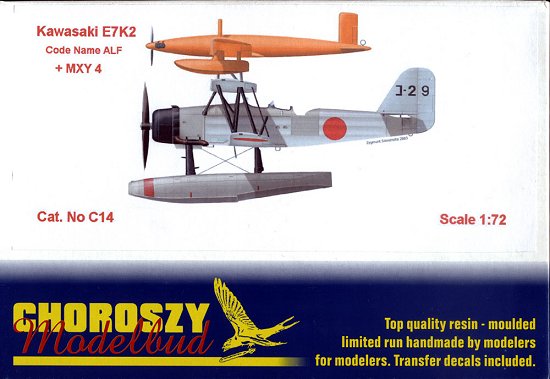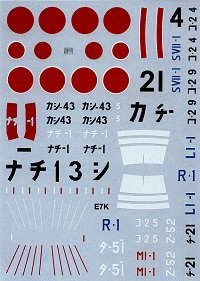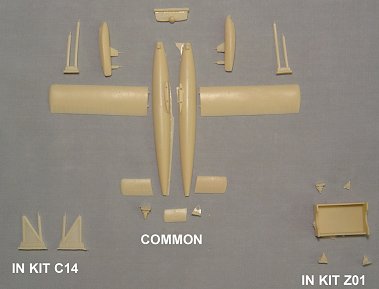
|
KIT: |
Choroszy Modelbud 1/72 E7K2 "Alf" with MXY4 Drone |
|
KIT # |
C-14 |
|
PRICE: |
$45 plus s&h when ordered direct |
|
DECALS: |
ten options |
|
REVIEWER: |
Bill Sanborn |
|
NOTES: |
Drone and Alf can be ordered separately. |

|
HISTORY |
The Kawanishi E7K2 was formally known as the Navy Type 94 Reconnaissance Seaplane Model 2 (later Model 12). To the Allies it was simply “ALF.” The E7K1 design was accepted for production in 1934 to replace the Navy Type 90-3 Reconnaissance Seaplane (E5K1). The E7K1 (Navy Type 94 Reconnaissance Seaplane Model 1) was a three place, twin-float biplane initially powered by a 500hp Hiro Type 91 12-cylinder W liquid–cooled engine driving a two-blade wooden propeller. Later production models had an upgraded 600hp Hiro Type 91 engine driving a four-blade wooden propeller. Armament for the aircraft consisted of a single 7.7mm fixed forward firing MG and two flexible (one dorsal, one ventral) 7.7mm MGs. The plane was equipped to carry 4x30kg or 2x60kg bombs. In 1938, the E7K2 was born when the plane was re-engined with a 870hp Mitsubishi Zuisei 11 14-cylinder air-cooled radial engine driving a two-blade propeller. Production of the E7K2 ended in 1941; however, the plane continued to serve in front line service until 1943.
The ALF possessed fine qualities and was well liked by its crews. The plane served from the catapults of many heavy warships and seaplane tenders as well as shore bases. It served in the liaison, anti-submarine, recon, and convoy escort roles. One of the many training roles was as an RC target plane and the mother aircraft for the MXY3 and MXY4 RC target drones. The E7K2s were progressively replaced throughout the first half of the Pacific war by the E13A “Jakes.” The ALF was almost continually in combat throughout its life, beginning with Japan’s conflict in China. By the end of the war, this old war horse was called back into service, like so many Japanese aircraft, to be expended as Kamikazes.
The Kugisho (Yokosuka) MXY4 (Navy Type 1 Target Plane Model11) was designed and built in 1940 and accepted by the IJN in 1941. The aircraft was designed as an all wood, radio-controlled target drone for gunnery training. The drone was powered by a 32hp four-cylinder Nihon Semi 11 box type air-cooled engine driving a 2 blade wooden propeller. It was carried aloft by an E7K “ALF” to 3000 meters and released. The drone had two floats under the wings for recovery.
|
THE KIT |

This is an all new kit of the E7K2 and is NOT a copy or modification of the old Hasegawa E7K1. Of the 4 E7K2 kits out there, this one blows the others away. The ALF has about 80 resin parts. The molding is crisp with some flash. The flash is not excessive with most occurring where needed to preserve fragile parts. The craftsmanship is excellent with few bubbles. The kit has a full interior and very fine surface detail. The fuselage is as thin as many plastic kits, but does not seem fragile. It includes beaching gear and well printed thin decals for 3 drone mother ships and at least seven other ALFs (if one wants to build the standard version). However, only one scheme is shown in the instructions, check references for the rest. It also includes 4 fantastic 30kg No. 3 ordinary bomb model 2 bombs and racks for the patrol variant. The bomb fins are molded on, very thin and look great! The only other option is long or short exhaust stacks. Spot checking the dimensions of the E7K2 kit shows that they are all within half a millimeter (~1.5” scale) of nominal based upon those listed in reference 1. While going over the kit, I found details that I had not noticed previously on an ALF. Sure enough, when I checked my references, they were there. Choroszy Modelbud has done their homework.
 I would
recommend this kit to the experienced modeler. It should be a fun, but
challenging build! The kit parts are well packaged in 12 separate small
zip lock type bags. The directions consist of 3 sheets front and back.
(one full page for three view of the plane, one side for the MXY4, one
side for history and catalog, the rest is exploded views for assembly and
decal placement-one A/C). The exploded views are a little crowded, but
most modelers will be able to follow them. This three-place open cockpit
plane just begs for super detailing of the interior, but is not needed as
Choroszy Modelbud gives you a lot of parts for the interior. It will look
good even if you don't add a thing! You may want to make sure to have
references ready to aid in placing all these interior parts. The float
struts look stout enough to support the plane, but the modeler will want
to evaluate the wing struts and
I would
recommend this kit to the experienced modeler. It should be a fun, but
challenging build! The kit parts are well packaged in 12 separate small
zip lock type bags. The directions consist of 3 sheets front and back.
(one full page for three view of the plane, one side for the MXY4, one
side for history and catalog, the rest is exploded views for assembly and
decal placement-one A/C). The exploded views are a little crowded, but
most modelers will be able to follow them. This three-place open cockpit
plane just begs for super detailing of the interior, but is not needed as
Choroszy Modelbud gives you a lot of parts for the interior. It will look
good even if you don't add a thing! You may want to make sure to have
references ready to aid in placing all these interior parts. The float
struts look stout enough to support the plane, but the modeler will want
to evaluate the wing struts and
 support frame for
mounting the MXY4. Most will be easy to copy in styrene if
additional strength is desired. A sheet of clear plastic is
included for windscreens, but no templates are provided, so hit the
references for help in making the windscreens. Fortunately, the
windscreens are simple, so making them will not be difficult. The clear
parts and instructions may be the only draw backs to this kit.
support frame for
mounting the MXY4. Most will be easy to copy in styrene if
additional strength is desired. A sheet of clear plastic is
included for windscreens, but no templates are provided, so hit the
references for help in making the windscreens. Fortunately, the
windscreens are simple, so making them will not be difficult. The clear
parts and instructions may be the only draw backs to this kit.
The MXY4 consists of about 20 parts and what can I say? This is a really unique subject and the only kit available of this drone. My samples are well molded and the engineering looks good. There were some bubbles in the cylinder heads, but a little filler will fix that without damaging the detail. The stand alone kit (kit# Z01) comes with a wheeled cradle and the drone with the E7K2 has mounting hardware to put it on the upper wing of the ALF. The instructions for the drone are very easy to follow.
|
CONCLUSIONS |
If you want an E7K2, this looks like the kit to get. The kits do not come cheap, but they are hand-made limited-production museum quality kits and you get what you pay for. If you have not built a resin, give this one a try. I cannot wait to get a hold of Choroszy's E7K1 kit (kit#s C13 or B58). The kit E7K2 is available both with (kit #C14) and without (kit #B59) the MXY4. The MXY4 is also available on its own (kit# Z01).
|
REFERENCES |
1) Maru Mechanic #36, Kawanishi Navy Type 94 Reconnaissance Seaplane (E7K), Kojinsha Publishing, September, 1982.
2) Famous Airplanes of the World #47, Imperial Japanese Navy Reconnaissance Seaplanes, Bunrindo Publishing, July 1994.
3) Francillon, R. J., Japanese Aircraft of the Pacific War, Naval Institute Press, 1988.
The Author wishes to thank Choroszy Modelbud (http://www.modelbud.pl/index_eng.htm ) for the evaluation samples.
If you would like your product reviewed fairly and quickly by a site that has over 200,000 visitors a month, please contact me or see other details in the Note to Contributors.